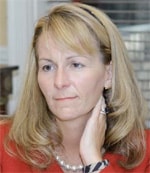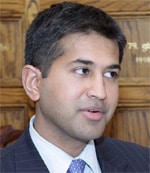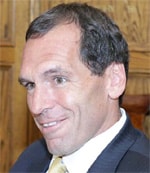Global custodians play a key role in helping their clients weather financial turmoil. Global Finance gathered a group of the industry’s leading players to discuss the implications of—and opportunities presented by—recent events.
 |
|
White: The market is reminiscent of 9/11, the way we’ve been hunkered down in our respective bunkers. |
GLOBAL FINANCE: Sovereign wealth funds have become a major investor class. How do their styles and needs differ from other investors, and how does this affect services they demand from custodians?
PETER CHERECWICH, chief operating officer for corporate and institutional services, Northern Trust: One of the things that make these sovereign funds different is the scale and diversity of their investments. Large direct investments are made as well as significant contributions to private equity, commodities, derivatives and traditional equities and bonds. The breadth of what they invest in and the complexity of those investments set them apart from other organizations.
KAMAL PALLAN, managing director and regional custody product executive, J.P. Morgan: Sovereign wealth funds have been around for a long time, but what is new is the sheer size of them, driven in part by record prices in commodities and trade surpluses in many Asian economies. Various research shows total assets under management as of May of this year to be as high as $3.7 trillion, larger than hedge fund or private equity investments. Some of the most experienced sovereign wealth funds tell us that they think of themselves not as a distinct investor class per se but simply as highly sophisticated, multiple-asset-class investment managers. In our experience, they are leading change agents and continue to push us forward collectively because of the breadth of their investments and the services they need.
KERRY WHITE, first vice president and manager of tax-exempt business, BNY Mellon Asset Servicing: In some ways they do look much like a large public fund that runs the gamut in terms of investments. From the custodian’s perspective, though, they pose a different challenge, not in how they invest but, for example, in the way they behave about their sovereign status and in their tax status. As a fiduciary they pose a challenge in terms of transparency and because they do benefit from this rather favorable tax status around the world.
CHERECWICH: Because of the market impact that the investments, as well as security and currency movements, could have, we have to be very careful about what information gets out in the marketplace. A lot of sovereign wealth funds have code names and privacy rules that have been implemented.
GF: Custodians are receiving more requests concerning transparency and risk, especially as clients try to improve their understanding of the possible impact of hard-to-value derivatives. What have custodians done to help their clients in this context?
 |
|
Pallan: Our clients want to wake up tomorrow morning and know that their custodian is still in business. |
PALLAN: As a custodian, we’re not just processing or settling trades. We’re providing our clients with insight into their portfolios, how their portfolios are performing and the risk embedded in their portfolios. In terms of derivatives, the biggest challenge is around OTC derivative contracts. There are three main “pain points” that custodians are tackling. First point, on valuation and pricing, we provide clients with the choice between independent valuations, calculated using market data and models, or third-party pricing services. Transparency as to source of pricing is critical. Another pain point is managing all of the events across the lifecycle of a derivative from trade capture onward. As an industry, we’ve made considerable progress working collectively to address regulatory and other concerns about processing efficiency. Finally, custodians provide risk analytics, which have been extended to derivatives, among other asset classes.
CHERECWICH: The term “derivatives” is utilized to describe a host of investment options. The valuation process, level of transparency and insight across all of these investments are very different—and some more difficult than others. As an industry, we have to help our clients understand that we are all on a journey, working with both the sell side and buy side, to continue to automate these new, esoteric types of derivatives while providing our clients as much information as possible.
WHITE: It is a journey. And just when you think you’re halfway through, another derivative is invented and there’s a new way of trading it or a different place to trade it. The three words we continue to see at the forefront of our clients’ minds are transparency, accountability and security. All of those factors apply to the esoteric securities that our clients are dealing with. We really have to understand what’s behind them and how they trade. Valuations continue to be a concern for our clients, as well as understanding who the counterparties are and identifying concentration risks. Clients with a basket of these types of derivatives need to know if they are overly exposed to one issue or to one dealer in particular. The journey continues to get more and more exciting.
CHERECWICH: As an industry we all have risk offerings, but we have to differentiate between risk reporting based on the data the custodian has and the provision of a robust risk system for clients to do scenario analysis.
GF: The structure of the US financial system is under severe strain. How is this affecting clients’ view of custodians?
WHITE: This turmoil has created an awful lot of concern and consternation across the industry. Clients are concerned about what it means for us as banks—what’s on our balance sheet and how this affects us as a custodian of their funds. They want to know what measures we’re taking in terms of managing our securities lending activities, our collateral pools, our sweep vehicles. We’ve been proactive in trying to address all of these concerns in an incredibly fluid, if not unprecedented, environment.
PALLAN: Simply put, our clients want to wake up tomorrow morning and know that their custodian is still in business. Given recent events, that is a valid concern, so there’s a flight to quality. We expect that to continue; if anything, it will be an ongoing process. Clients are looking less at just the cost of custody and more at the quality of their custodian. They want to see a fortress balance sheet, with strength and stability. Also, when markets are changing hour by hour and entities are filing for bankruptcy, they want constant information. They want insights on developments in a way that they may not have needed before. Finally, quite apart from the balance sheet, the transparency, the information, it’s the service that our clients need to get through really tough times like this.
 |
|
Cherecwich: If the emerging markets have reserves and they want to invest them, then this could help. |
CHERECWICH: This flight to quality is really being led by hedge funds. There is no question that everyone in this industry is getting phone calls, and we’re all working on how fast, frankly, to put those clients onto our books. For the first time in my 20 years, I’ve seen that the credit rating and the solidity of the custodian is the most valuable aspect.
GF: What do you think is going to be different about the financial world going forward?
WHITE: Sadly, the market is reminiscent of 9/11, the way we’ve been hunkered down in our respective bunkers, on the phone with our clients 24/7 and educating non-US clients about “bankruptcy law 101,” for example. These are issues that you never expected to be working on, but I think potentially, like post-9/11, we could see a better-organized operation or maybe even an umbrella structure of regulators. Sometimes you need a real crisis to make different agencies work together. Personally, I would like to see regulators operating in a more cohesive fashion.
PALLAN: The impact on custodians may be significant, driven by the demands of the regulators and the needs of our clients. We may see a more coordinated approach to regulation with the view of getting more transparency into what investors are doing.
CHERECWICH: It will be interesting to see how all this affects the competitive landscape. It’s not a surprise that Goldman and Morgan Stanley are now banks, but what does that mean? Wall Street as we know it is gone. What is the new prime brokerage model? Will OTC derivatives move more toward an exchange-traded format? These questions will have pretty major consequences for our industry and how we have to change the plumbing to make it work in this new structure.
GF: Pension clients have been moving from defined benefit [DB] to defined contribution [DC] plans. How will the current market turmoil affect their actions now?
WHITE: Aging populations are having a huge effect on the way benefit plans are evolving, shifting away from traditional defined benefit plans into defined contribution schemes. This is a global trend. DC assets, roughly $6 trillion now, are poised to grow to over $40 trillion by 2040. I did some research about the volatility that occurred in September, tracking the funded status of S&P; 500 corporations as a bellwether of how DBs are doing. At the beginning of 2008, they were on average 97% funded, so there was already a shortfall. At the beginning of September, the numbers were at 82%, but a couple of weeks later they were back up to 92%—still a significant shortfall. The shakeout in financial services could really have a tremendous impact, because the unfunded portion of companies’ benefit plans is considered an unsecured debt.
CHERECWICH: The most important skill for the custody industry is the ability to react to the trends. We have to be there to support whatever structures exist, and as a group we have to provide services that will help ensure there’s no panic. We must ensure the money stays in the system.
PALLAN: The pension industry is going to continue to grow, and you’re going to continue to see a shift from defined benefit to defined contribution schemes. What we as custodians have to do is make sure that we can accommodate this shift and provide the services, expertise and insight that our clients need, whether it be performance analytics, compliance, consulting or services designed specifically for defined contribution schemes.
GF: Recent regulatory announcements may be changing the role of custodians. What’s happening?
PALLAN: I’d like to address two areas where custodians are actively involved. The first is around understanding regulations that are imposed upon our clients and what we as custodians need to do to help them respond to those regulations. An example is the recent FAS 157 requirement. The second is around self-governance, where we as an industry come together to address issues and concerns in a coordinated way for the benefit of the markets and our clients. Both of these elements are increasingly important aspects of the custodian’s role.
CHERECWICH: One of the significant things we’ve seen is that the regulations are changing the role of the custodian into an educator; our clients are looking to us to help interpret how these regulations will impact them, what they should do. It’s not good enough simply to have a product; you have to be able to explain it and help ensure the client understands all of the nuances.
WHITE: As an industry, we’re very involved in working groups that help draft the legislation, which means we can educate our clients upfront about what to expect. Once it finally does come into play, the education role becomes even greater. What we are also looking at is the way we organize our technology for our clients. All of us have wonderful online reporting capabilities, but sometimes clients say there’s too much out there. We are creating more thematic types of pages within our online reporting capabilities to help present the information in a more orderly fashion for clients.
GF: Are we in for an extraordinary change in the level of regulation over the next few months in the United States?
WHITE: Yes. Certainly we’re seeing change in terms of the regulations that we have to abide by.
CHERECWICH: You’re going to see more reporting requirements, which will impact us first. Clients will also want information more and more quickly.
PALLAN: It comes back to transparency. The changes we face will be around reporting and monitoring for our clients.
 |
|
Giarraputo: The maturing of the emerging markets is having a major impact on the industry. |
GF: The convergence of investment styles between traditionally long-only managers and alternative investment managers continues. What are the latest developments in the area, and how do they affect these managers’ service providers?
CHERECWICH: We’ll continue to see more unlevered or very slightly levered portfolios use all the different available asset classes that are out there. At the same time, you’ll see fewer highly leveraged funds, and that’s simply an impact of the current market. However, the types of OTCs that exist will still proliferate and be utilized, but in a more conservative manner.
PALLAN: Traditional funds are behaving more like hedge funds at the same time as hedge funds are becoming more institutionalized by asking for things that our traditional clients have always wanted, like accounting services. This means, for example, that custodians need to support both long and short positions and consolidated reporting across both. At the same time, custodians are increasing their derivatives processing capabilities and looking to integrate a wider range of services supporting a broad spectrum of investment strategies. As custodians we have to be able to handle leveraged portfolios and bring the entire bank—whether it’s prime services, financing or synthetics—to our clients.
GF: Growing internationalization and maturing of many “emerging markets” is having a significant impact on our industry. What change has this brought to the investors and service providers, and how do you expect this to develop?
PALLAN: What five years ago was a frontier market is today likely to be more mainstream. At the same time that the markets are maturing, we’re seeing our largest clients truly globalize their investments and operations. Where they may have been in just one time zone, they are now aligning operations globally. As custodians we need to be with our clients as they move globally. Developing countries and their citizens are becoming more affluent and exporting capital. Our clients are setting up local operations to tap that new affluence, and as they do, we have to follow them—or, in many cases, anticipate their movements.
CHERECWICH: For the most part this industry has taken a tack where client service is placed close to the client’s time zone. Clients are putting not only offices in other locales but also their operations. It’s not just providing local service to our clients; it’s facing off at the operations level, too. We have our operations team in a particular country talking directly to our client’s operations team in that same country, even if it is only an operations center. The only way to do that is to continue to invest in building a global platform; otherwise it just doesn’t work.
WHITE: One key factor is that the investments from emerging economies are not at all basic, as some might expect. They instantly come with very sophisticated types of investment programs. They have amassed a mountain of capital, and their investments are of a level where they look for, and expect, client-facing people to be close by. The days of having hubbed operations out of the US to service your emerging market customers are long gone, as evidenced by our rapidly growing on-the-ground presence in the Middle East and Asia.
GF: Given their enormous reserves, is it possible the emerging markets will save the global financial system?
CHERECWICH: If the emerging markets have reserves and they want to invest them, then this could help bring stability to the marketplace. What’s more important for us, however, is to make sure that we’re looking at these different markets with an eye toward expanding our global operating model and utilize these markets as growth engines.
GF: It’s been several years since the initial deals between investment managers and custodians for middle-office outsourcing. Is this movement picking up speed in the current market? How do custodians propose to help investment managers focus on their core businesses?
WHITE: Yes, the market is picking up. We see many medium-size investment management firms looking to outsource non-core functions because they distract these firms from their own core competencies and are resource-inefficient. Investment management firms are looking for help with billing or with a variety of different administrative functions that don’t add value to the process they want to focus on, which is investing money.
PALLAN: We see the trend accelerating. There’s a tremendous amount of complexity that investment managers have to deal with, such as derivative processing and valuations, and many of them don’t have the capability or desire to manage these functions directly anymore. The first few outsourcing deals several years ago were highly customized “lift-outs,” which turned out to be a challenging model for both clients and service providers. As an industry we’re moving to a model that is much more component-driven and on the service provider’s standard platform. Thus, we can package the services that each client wants with components that are not totally customized for each deal. This allows us to provide enhanced functionality coupled with economies of scale and efficiency. It’s not “one size fits all,” but it’s moving toward a more standardized model.
CHERECWICH: The trend is definitely increasing, and for the first time I’m seeing deals being geared more toward meeting capabilities rather than reducing costs. That’s a huge shift, driven by the need to process derivatives or expand internationally. Operations are saying to investment managers, You can’t invest in those structures or sell those mandates, because we don’t have the infrastructure, the compliance, or the risk tools to do the job. If they want to, they have to either spend a lot of money or outsource. Also, all custodians are at a different stage in terms of how standardized their model is, but as an industry we can now say that we have systems that are in place. We can price it so that we can make a reasonable margin while the client can see both the capability and cost savings that they’re looking for, too.
GF: Will recent events affect that trend?
WHITE: If anything, it actually might accelerate the rate at which people will make decisions, and it might prompt them to extend the number of components that they would take from an outsource provider beyond the deep back office into the middle office because they’re challenged with so many other things themselves. As investment management houses are planning into 2009, they really have to figure out where they are going to get the growth. Investing in more technology isn’t necessarily going to deliver dividends the way outperformance or hiring some topnotch talent would, in terms of being able to manage more portfolios or go out and win business.
GF: Technological innovation has been a recurring theme in the custody business. What can we expect in the future?
PALLAN: What you will see change is how technology investments are spent each year. Systems are becoming increasingly component-based. We’re trying to build things that are “plug and play” as much as possible. Our clients have tremendously complex needs, and not everybody wants the same things. So we’re looking at how to build a system that’s scalable where you get the cost benefit but at the same time the clients get what they want. The other thing that’s happening with the current technology is this idea of bringing the best of the bank to the client. It’s much easier now, because of technological advances, to knit together things that were not possible a few years ago. For example, we can now talk about things like integrated execution, clearing and custody. Finally, we’re in an age of real-time data and extensive data mining; this plays a real role in how we think about delivering information to our clients.
CHERECWICH: Once you’ve knitted things together and offered those components, you have to present it. I think we all look for the newest cup-holder to put in the car, but the reality is lots of us have features and functions in our front ends that continue to not be fully utilized. The online portals are filled with huge numbers of reports. I think one of the things you’ll see is an investment in simplification, trying to narrow down the number of reports, while also standardizing them—not because we’re trying to cut costs but, rather, trying to provide our clients reports that are more and more intuitive. Our aim is to create a system that intelligently links information to make it easy for our customers to get what they’re after so it will become more and more efficient for our clients to do business with us.
WHITE: It is imperative to make sure we provide what our clients want. We have all this plumbing and wiring—the infrastructure that holds all of this together—but we continue to spend a lot of time making the view that the client has on their desktop something that is more germane to them. Our thematic pages are capabilities that sit in front of the client and route the type of information that’s relevant to them. We’re also making the reports faster and deeper so we can provide the speed, accessibility and the drill-down and language capabilities to meet our clients’ needs.
CHERECWICH: The standard we’re working toward achieving is what people expect from the Internet in their personal lives. They want there to be no difference between them hitting a search button and hitting the button to recalculate a return that goes back five years and has to go into a data warehouse. That expectation of how fast they get information back is driven by the marketplace, not by the custodians. If we want to maintain perceptions that we’re on top of it, we’ve got to continue to invest in technology to provide that speed.
GF: Is the custody competitive model changing as a result of the recent turmoil?
CHERECWICH: It did change the playing field a little, but not for the big players. A year ago we talked about the prime brokers and other players on the fringes of the industry potentially getting into the custody business, but that threat seems to have gone away.
WHITE: It’s such a heavy spend on technology; nobody will be entering the market that hasn’t been here already, except possibly a non-US player who already has the resources.
PALLAN: I think it is going to change how we talk about the value that we provide to our clients, and some of that value will be things that our clients may not have thought as much about a year ago. The focus will be more on institutional quality, reporting, risk management and service—and less on price.
Joseph Giarraputo



